There have been inherent problems with audio frequency conducted susceptibility tests since their inception. These are: ensuring that the injected signal drops across the test sample; monitoring the signal that is developed across the test sample, both from the point-of-view of isolating the instrumentation so it doesn’t ground the input power return and, more problematically, monitoring injected ripple riding on an ac bus potential. These issues are resolved using a novel but inexpensive transducer described herein.
Requirements for equipment to operate compatibly with various levels of ac ripple imposed on primary power inputs (both ac and dc) have existed in US military standards since the 1950s, and in commercial avionics requirements, such as RTCA/DO-160, since at least the 1960s. The basic set-up for this testing is either that in Figure 1, or something very similar.

Figure 1: MIL-STD-461F CS101 test set-up
By inspection, the series injected potential must drop across the test sample power input, and/or the power source. Ideally, enough of the injected potential drops across the test sample so that the required ripple potential is developed there. The purpose of the 10 uF feedthrough capacitor is to be a low impedance shunt at frequencies where the LISNs become a significant impedance, forcing most of the injected potential to drop across the test sample. For a dc bus, the capacitor value can be increased without bound, and a value such as 10,000 uF ensures, for all practicality, that the injected potential does indeed appear across the test sample. But for a 400 cycle bus, 10 uF is an upper bound, and thus its appearance both in MIL-STD-461 and RTCA/DO-160.
The bottom line here is that it is critical to monitor the ripple across the test sample input; monitoring at the injection point is insufficient.
Given that the return line is generally above ground, the monitoring device, traditionally an oscilloscope, cannot artificially ground it via the oscilloscope probe ground connection. That is why Figure 1 floats the oscilloscope via an isolation transformer. In modern set-ups, with the monitoring device often connected to computer automation, this floating set-up is complicated by the interface with the automation. Better approaches are inherently floated oscilloscopes, such as those offered by Fluke and Tektronix that are “wall-wart” powered, with optically isolated computer interfaces and thus completely isolated from safety ground.
Finally, when the test sample is powered from an ac bus, it is quite difficult to monitor the injected ripple riding on the ac power waveform due to the large ratio of potential involved. The maximum ripple limit is 6.3 Vrms in MIL-STD-461 CS101, and that is riding on 115 Vrms. A still shot of the injected ripple at 800 Hz riding on a 400 Hz bus is shown in Figure 2. In the digital edition of this issue, the picture is a video and the difficulty in measuring the audio ripple is more obvious.
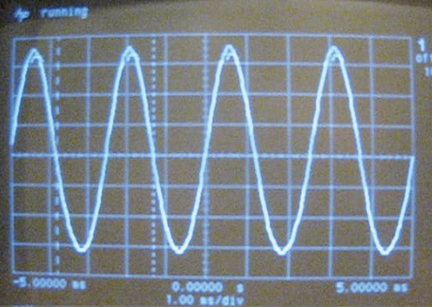

Figure 2: 800 Hz ripple superimposed on 400 Hz power (snapshot top, envelope bottom)
Prior to 1993, a “phase-shift network,” Model 7021-1 by Solar Electronics, was available to ease this problem. It worked on the principle that the phase of the ac power waveform was 180 degrees reversed between the power source and the test sample so that if one used transformer action to sum the potentials across the power source and load, the result would be only the injected ripple, which would be in phase across power source and load. This works well if all the injected ripple drops across the test sample, but if any has dropped across the power source it gets added to the ripple across the test sample, and the technique then overestimates the ripple level across the test sample alone. It is as if the injected ripple were simply measured at the point of injection, which would be much simpler. For this reason, the phase shift network technique of monitoring the test sample ripple was proscribed in MIL-STD-462D in 1993, and ever since.
With the loss of the phase shift network, the ability to monitor injected potentials at frequencies below that of the ac power waveform was likewise lost. The lower frequency modulation appears as a rolling change in amplitude that is impossible to gauge because its full value appears only across many cycles of the ac power waveform. So in 1993, MIL-STD-461D (and all subsequent revisions) began the CS101 limit for ac-powered equipment at twice the line frequency, omitting the formerly required spectrum down to 30 Hz.
Other Approaches
A useful but expensive approach is to use a dynamic signal analyzer (DSA) to view injected ripple in the frequency domain, allowing separation from the power frequency component. A DSA is an oscilloscope (1 Megohm input resistance) with a built-in fast Fourier transform (FFT) capability (see Figure 3). With this technique, the ac bus potential has to be attenuated, but the attenuation factor is 3 or 4, and that allows plenty of dynamic range to see the injected ripple potential. Two downsides are the cost ($10,000 – $20,000) and the fact that these devices operate to around 100 kHz, requiring a different technique to cover 100-150 kHz. This latter isn’t a technical problem, but it does complicate and lengthen the test.


Figure 3: Commercial dynamic signal analyzers
The author tried another technique using a distortion analyzer. The concept was to zero out the power waveform without any injected ripple, and then anything that would show up when ripple was injected would be the desired quantity to be measured. In practice, not enough of the power frequency waveform could be nulled out to enable reading the injected ripple accurately.
The Solution
The Figure 4 power-line ripple detector (PRD) network was developed by and for the EMC Compliance test facility as a CS101 test aid to overcome the problems described above. The PRD is an interface between the power bus and a low-level analyzer/receiver input, so the same analyzer/receiver presently used for CE101 testing can now also be used for CS101 and RTCA/DO-160 section 18 testing as well. Figure 4 shows inputs for connections across the test sample power input and the power output (LISNs), a bnc connection to the spectrum analyzer/receiver, and two switches to control which input is monitored and the frequency response of the transducer.

Figure 4: Power-line ripple detector
The Figure 4 test aid will soon be available as a commercial piece of test equipment. The price of the PRD transducer is expected to be less than 10% that of a high-end dynamic signal analyzer instrument.
Figure 5 shows the PRD connected across the test sample (light bulb on power strip) power input, across the power output (LISNs) and with its bnc output connected to a 50 Ohm input spectrum analyzer or EMI receiver (not shown).

Figure 5a: Audio frequency ripple injection using PRD
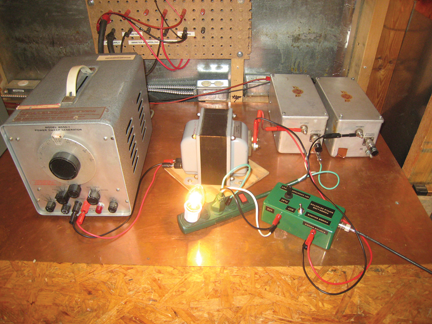
Figure 5b: Audio ripple injection using PRD (10 uF cap removed, analyzer not shown)
The PRD is a passive signal conditioner that acts as an attenuator, impedance match, and isolator. The latter property allows the spectrum analyzer/EMI receiver to operate with safety ground intact, while maintaining the isolation of the test sample power return above ground. Attenuation can be either frequency independent, nominally 66 dB1, individually calibrated, or, at the flip of the right-hand switch (Figure 4), the attenuation above 5 kHz rolls off at 20 dB/decade to match the slope of the MIL-STD-461D/E/F CS101 limit. With this switch position selection, the output of the PRD into the spectrum analyzer/EMI receiver is independent of frequency across the entire CS101 test frequency range at a nominal 70 dBuV, or 3 mV. This allows for very easy testing, even in manual mode, with a cursor or threshold set at the 70 dBuV target.
The other switch in Figure 4 selects between the test sample power input and the power source (LISN) end of the test set-up. If the required limit cannot be established across the test sample power input, and the 80 watt limit has been reached, a flip of the switch allows a quick reading of the ripple potential dropped across the power source.
If that level is enough that, added to the ripple across the test sample the sum meets the required limit, then action must be taken to reduce the power source impedance so that the missing ripple potential moves from the power source to the test sample power input. Test methods CS101, RTCA/DO-160 Section 18, and similar should require this as a matter of course. Absent this requirement, the test is not well-controlled and repeatable.
In order to interpret Figure 6, the transducer factor of 66 dB must be added to the signal levels shown. The 400 Hz power waveform, thus adjusted, represents (95 dBuV + 66 dB = 161 dBuV) 112 volts, and the 800 Hz ripple at 70.4 dBuV is 136.4 dBuV, right at the limit. Comparison of the Figure 6 frequency domain sweep to the ripple superimposed on the ac bus potential in Figure 2 should say everything that needs to be said if the reader has performed this test before and can envision trying to assess the ripple modulating the peaks of the ac power waveform. For those lacking the experience, the video in the digital edition is instructive.

Figure 6: 800 Hz ripple in span containing 400 Hz power bus fundamental and third harmonic
The ability to measure ripple injected below the power bus frequency is demonstrated by comparing Figures 7 and 8. Again, Figure 8 in the digital edition is a video clip of the low frequency modulation rolling through the 400 Hz waveform. Careful inspection of the snapshot picture reveals that the amplitude is changing from cycle to cycle; the envelope is on the right.
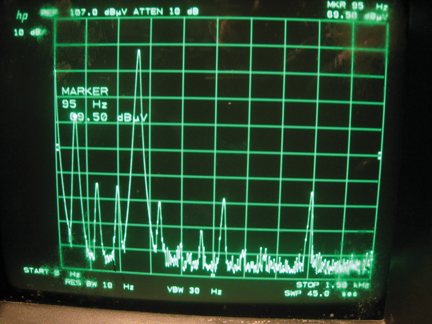
Figure 7: 100 Hz ripple in span from dc to 1 kHz

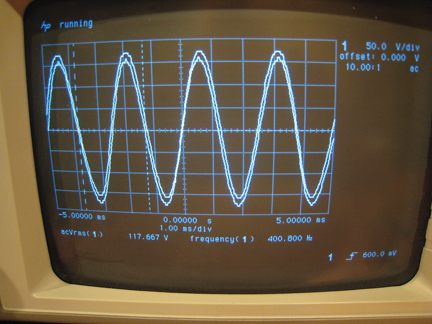
Figure 8: 100 Hz ripple superimposed on 400 Hz power (snapshot left, envelope right)
Absent the proscribed phase shift network, injected 100 Hz ripple on a 400 Hz bus is at best difficult to measure in the time domain because the modulation peaks are separated across many cycles of the ac bus. However, when using the PRD to facilitate a frequency domain measurement, measuring below the power bus frequency is no different than measuring above it.
Injection below the power frequency would be an added benefit for MIL-STD-461G, recovering the spectrum lost since 1993, but injecting ripple below the power frequency is already required in MIL-HDBK-704-2 through -6 (400 cycle, wild frequency and 60 Hz buses). Adoption of the use of the PRD’s functionality could thus enhance MIL-STD-461, and service existing test methods in MIL-HDBK-704.
Figure 9 shows 6.3 Vrms ripple at 1 kHz using a sweep from 300 Hz to 1.3 kHz. The power frequency and second and third harmonics are visible in addition to the injected ripple. If the span is modified to be centered on the ripple frequency, and just wide enough to display the injected waveform, as in Figure 10, then the same test automation routine that is used with MIL-STD-461 requirement CS114, or RTCA/DO-160 section 20 conducted rf susceptibility, may be applied when automating audio frequency ripple injection. The routine commands both signal source and spectrum analyzer/EMI receiver to the desired frequency, with a specified and fixed span for the analyzer/receiver. With only the injected frequency visible, the analyzer/receiver “marker-to-peak” function is invoked, and then the leveling feedback loop adjusts until the marker is at the desired level. This is how existing automation for rf conducted susceptibility testing is made available for audio frequency conducted susceptibility testing via use of the PRD.
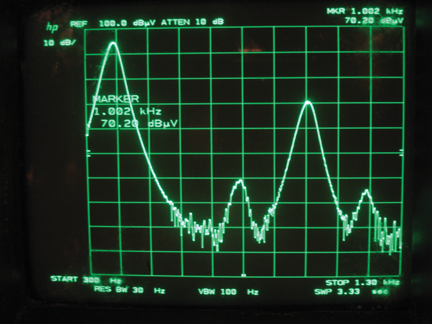
Figure 9: 1 kHz ripple in span to 1300 Hz
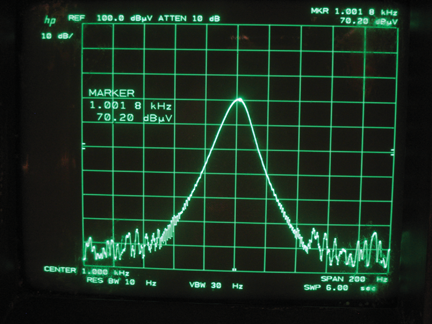
Figure 10: 1 kHz ripple at center of 100 Hz span
The only place this doesn’t work well is very close to the power frequency. Prior to 1993, MIL-STD-462 CS01 had an exclusion zone within 10% of the power frequency. Using the MIL-STD-461E/F 6 dB bandwidth of 10 Hz, the closest “approach” to the power frequency at a level 25 dB below the bus potential is 15 Hz away. For 400 cycle or wild frequency power, that is well within the 10% window cited above2. Also, any span that includes the power frequency won’t be able to use the marker-to-peak function to level on the test signal, because marker-to-peak will seek out the power frequency. If it is possible to have the injected signal at the span center frequency, a “marker-to-center-frequency” command could be used. If that isn’t available at very low frequencies, a zero-span command could tune the receiver to the test signal frequency, and excludes all else. This, however, relies on extremely accurate and stable tuning so that the peak of the test signal is captured.
For the record, the PRD’s function allowing frequency domain viewing of injected ripple isn’t necessary for dc-powered test samples. The device works just as well on a dc as an ac bus and, by providing isolation, removes the need for an isolation transformer on the monitoring device. While the PRD isn’t necessary to monitor audio ripple injected on a dc bus, the fact that it can be used simplifies testing in that the set-up, software, and bookkeeping is identical between ac and dc-powered test samples.
Conclusion
An inexpensive transducer (PRD) that solves several long-standing issues with audio frequency conducted susceptibility testing has been developed at the EMC Compliance test facility. The PRD facilitates the use of a spectrum analyzer/EMI receiver to monitor injected audio frequency ripple. By separating the injected ripple from the power waveform, the PRD allows accurate and very simple monitoring of the injected waveform, something that has been difficult or extremely expensive to do until now. The PRD inherently provides isolation, so the analyzer/receiver need not be transformer isolated. The PRD also provides a quick check to see if excess ripple is dropped across the power output if not enough is measured across the test sample power input.
The PRD is being commercialized by Pearson Electronics and will be demonstrated at the Pearson Electronics booth during the 2012 EMC Symposium in Pittsburgh.
![]()
Notes
- The nominal 66 dB factor is for a PRD that works with all power bus potentials up to and including 120 volts, ac (rms) or dc. Another model works on buses from 120 volts to 270 volts, again ac (rms) or dc.
- Using a 3 Hz 6 dB BW allows injection within 5 Hz of the power frequency, which meets the 10% window for 50/60 Hz power. A 3 Hz BW is available on many modern EMI receivers but is not a requirement in MIL-STD-461.
